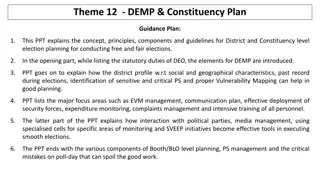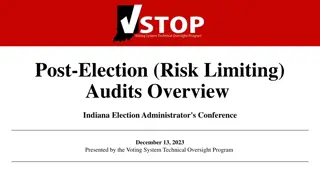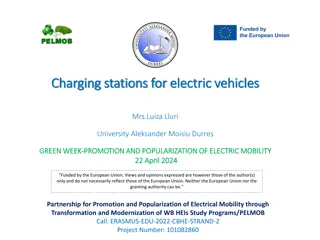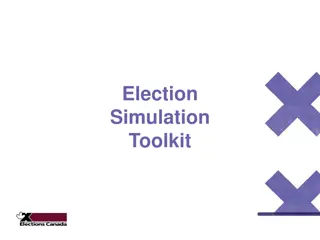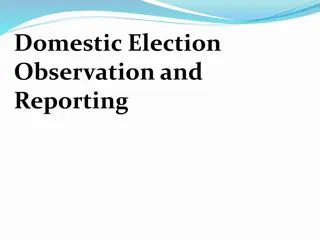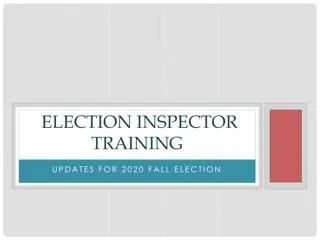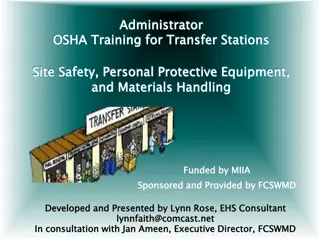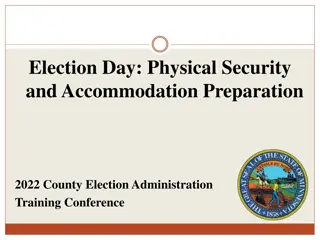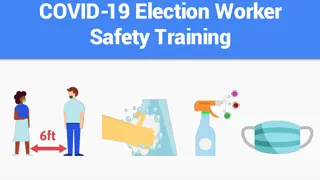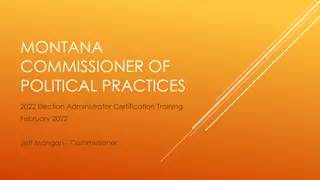Ensuring COVID-19 Safety in Election Stations: Protection and Communication Guidelines
Prioritizing COVID-19 safety during elections is crucial. Guidelines recommend ensuring vaccination of station workers, proper ventilation, mask-wearing, hand sanitizing, and physical distancing. Emphasizing outdoor setups, clear communication, and handling sick individuals can help mitigate risks. Effective communication to the public and workers, in various languages and plain language, is key to ensuring everyone's understanding and compliance with safety measures.
Download Presentation

Please find below an Image/Link to download the presentation.
The content on the website is provided AS IS for your information and personal use only. It may not be sold, licensed, or shared on other websites without obtaining consent from the author.If you encounter any issues during the download, it is possible that the publisher has removed the file from their server.
You are allowed to download the files provided on this website for personal or commercial use, subject to the condition that they are used lawfully. All files are the property of their respective owners.
The content on the website is provided AS IS for your information and personal use only. It may not be sold, licensed, or shared on other websites without obtaining consent from the author.
E N D
Presentation Transcript
Slides for Moseneke Commission Free and Fair Elections
Who is at risk? People running the voting stations Should ensure that all people working at voting stations are fully vaccinated more than 2 weeks prior to voting Voters especially over 60s and those with Obesity Diabetes Renal disease Cancer Heart disease HIV
Protection methods include adequate ventilation and no prolonged (>15 mins) exposure adequate ventilation Thus IEC plans are insufficient to protect the workers and the public. Wearing of masks (covering mouth and nose) is essential, BUT some so-called masks are inadequate such as those with valves and snugs . Frequent hand sanitising is recommended and critical in the context. Physical distancing is also important as this lessens (but does not eliminate) the risk of acquiring COVID-19
Ventilation is critical- more important than mask wearing Premises outdoors are preferable registration, name taking etc can be done outdoors. Premises need to have all windows and doors open fans to increase air circulation Regular breaks for inside workers is recommended to decrease prolonged exposure
Gloves are not helpful in this context and may introduce a sense of complacency. The spread of the virus can occur on gloved hands yet these might not be cleaned as often as bare hands (also a substantial wasted cost) Sick people What do to with people who are ill (even with mild flu like symptoms) on the day of voting needs to be thought through, as sick people should be discouraged from going to voting stations. Home visits are high risk as these voters are likely to be vulnerable and the workers to also be at risk. Where possible visits should remain outdoors
Communication Communication This is often a neglected area both to the public and to the workers. Communication about what to expect is important. The public must be informed about the protective measures and what will be expected of them. Workers need to be informed about the importance of the prevention measures particularly ventilation. They need to be taught how to handle people not wearing masks or not wearing them correctly in the context of the right to vote, how to deal with people not keeping sufficient physical distances. The communication needs to be in multiple languages and in plain language (not scientific jargon Creative communication using humour, stories and ways of relating that are familiar should be used All materials need to be tested with appropriate people to ensure that they are understandable and are giving the correct message (and not unintended messages) .
Allow special votes for all those at highest risk (who arent vaccinated) if possible





